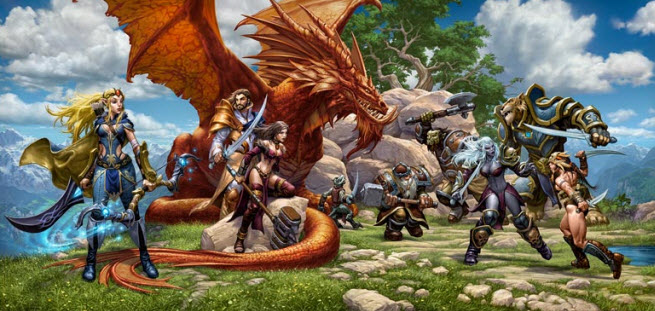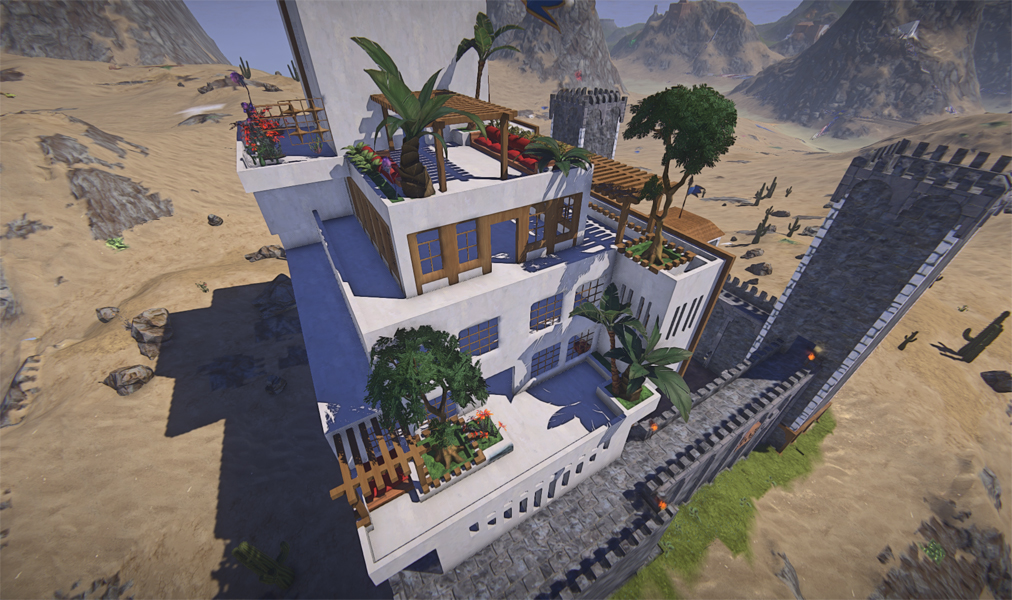If you build it they may buy it, or the developers might use it
Planetside 2 is also one of three current Sony Online Entertainment games that supports Player Studio, which enables players to create virtual items and upload them into the SOE Marketplace for purchase. In the case of Planetside 2, players can create armor pieces, camouflage schemes, cockpit designs, and decals. They’re all strictly aesthetic items, and Tramell said that one player creator has made over $12,000 since last September.
Permitting players to build items for use in-game is the essence of the other SOE game we saw at the Game Developers Conference. EverQuest Next Landmark is like a marriage of Minecraft’s creative mode with traditional MMO interfaces, and it’s part of SOE’s understanding that it isn’t good enough to just take new graphics and quests and lay them over the same, basic MMO design over and over again.
EverQuest Next will be a fully destructible world. EverQuest Next Landmark is a fully constructible world, and the two games are meant to interplay with one another. In fact, the tools that players will use to build things in EverQuest Next Landmark are the same tools that SOE’s designers are using to build EverQuest Next.
Landmark began as a way to encourage EverQuest fans to design content for the next MMO in the franchise. Dave Georgeson, the director of development for the EverQuest franchise, told us that the experiment snowballed into an idea for creating persistent worlds, set in the EverQuest universe that players would have complete control over, and that idea evolved into Landmark.
“The players, in the first two weeks of alpha, developed four or five, maybe even six different unique ways of using our tools that we were completely unaware was possible,” said Georgeson. The basic interface enables players to shape objects into new objects, which can then be saved as templates, and to use basic textures, as the basis for architectural construction, which is similar in spirit to Minecraft’s creative mode.
Landmark also borrows from Minecraft’s survival mode in that players aren’t given access to the full panoply of potential building materials right from the beginning of the game. Landmark players will spawn with a stone ax and a stone pick, and they’ll explore the world and sample materials in order to gain access to them in free construction. Players will then be able to combine simple materials into more complex materials and gradually unlock all of their building options.
“At the beginning of the game, one of the other things that you have in your inventory is a claim flag. It’s just like an Oklahoma Sooner rush, where they run out there on day one and everybody’s looking for a cool place to put their flag,” said Georgeson. Players control a cube of space around wherever they place their claim flag, with a buffer zone around that space to prevent other players from boxing them in, and players can eventually build more claim flags as they gather more resources.
“The world is deep, I mean, really deep. It’s like a mile deep, and it’s filled with caverns and things to explore,” said Georgeson. The deeper players go, the more valuable the resources they discover. Sound familiar?
Georgeson showed us one island in the demo, and it was already littered with player claims. “There are 50 islands on a world, and there are many worlds,” Georgeson said. Players can pick up and move their claims near the claims of other like-minded players if they all want to explore a certain architectural style of theme, for instance.
SOE will host contests wherein Landmark players build structures which the Landmark audience then votes on, and when the community has grown adept enough in their construction skills, Georgeson and his team will spin up Landmark worlds where the only restriction is that players work within the art direction of Norrath, the location of the EverQuest games.
“As we build Norrath we’ll be like, ‘Hey, we’re going to do Innothule Swamp this month, and here’s our art guide for what we’re gonna be doing. Anybody who wants to participate with us, these are the kinds of things we’d love to see,’ and then that stuff all gets pulled over and permanently part of Next,” said Georgeson.
VentureBeat's mission is to be a digital town square for technical decision-makers to gain knowledge about transformative enterprise technology and transact. Learn More


